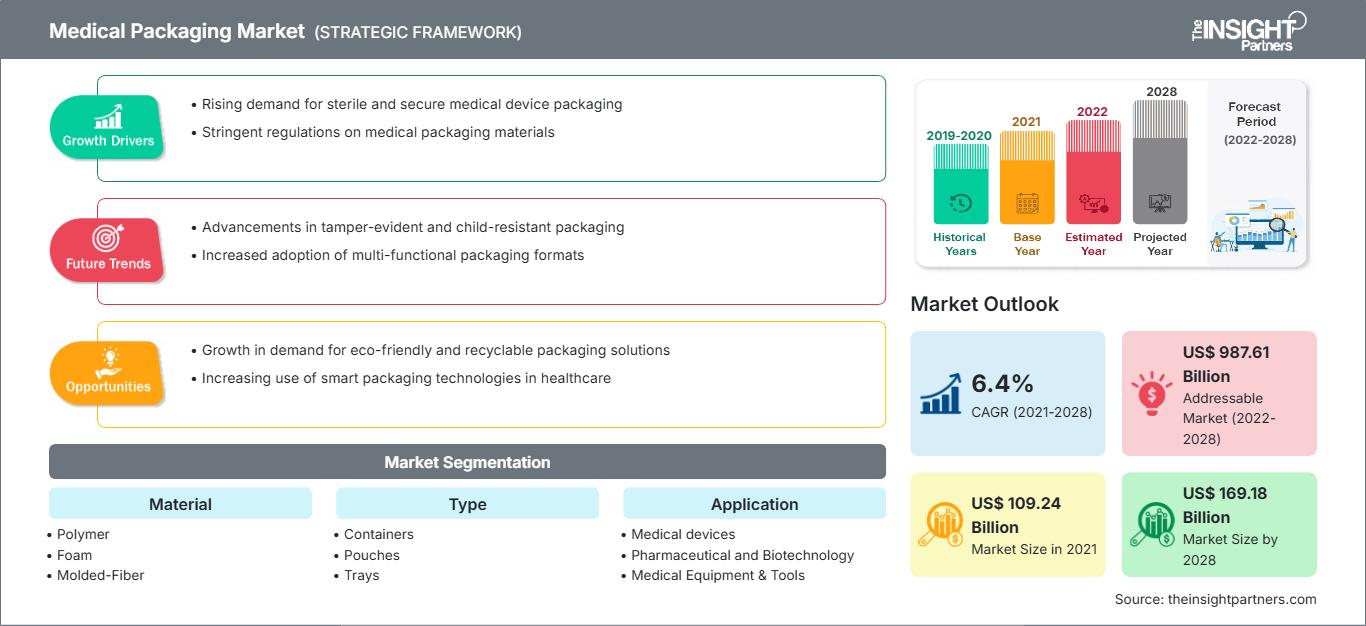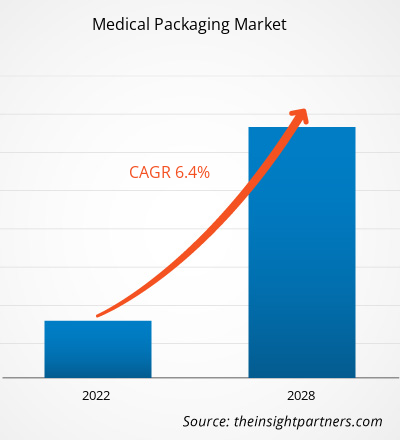Si prevede che il mercato del packaging medicale raggiungerà i 169.183,91 milioni di dollari entro il 2028, rispetto ai 109.238,35 milioni di dollari del 2021; si prevede una crescita a un CAGR del 6,4% dal 2021 al 2028.
Il packaging medicale è essenziale per garantire la qualità del prodotto e incoraggiarne un uso sicuro ed efficace. Il packaging è realizzato per garantire la sicurezza dei prodotti medicali durante la conservazione, la distribuzione, la vendita e l'uso. Il materiale utilizzato per il packaging è un sistema di barriera sterile che protegge farmaci, apparecchiature e altri prodotti medicali. Inoltre, il packaging medicale richiede un elevato livello di sterilità per garantire che il prodotto sia privo di contaminazioni. Questi sistemi di packaging medicale aumentano la sicurezza del paziente e ne migliorano le prestazioni. Fattori come la crescente attenzione alla praticità e alle problematiche ambientali e l'aumento della domanda di meccanismi di prevenzione della contraffazione stanno trainando il mercato del packaging medicale. Tuttavia, si prevede che le fluttuazioni dei prezzi delle materie prime limiteranno in una certa misura la crescita del mercato durante il periodo di previsione.
Personalizza questo rapporto in base alle tue esigenze
Potrai personalizzare gratuitamente qualsiasi rapporto, comprese parti di questo rapporto, o analisi a livello di paese, pacchetto dati Excel, oltre a usufruire di grandi offerte e sconti per start-up e università
Mercato degli imballaggi medicali: Approfondimenti strategici

- Ottieni le principali tendenze chiave del mercato di questo rapporto.Questo campione GRATUITO includerà l'analisi dei dati, che vanno dalle tendenze di mercato alle stime e alle previsioni.
Potrai personalizzare gratuitamente qualsiasi rapporto, comprese parti di questo rapporto, o analisi a livello di paese, pacchetto dati Excel, oltre a usufruire di grandi offerte e sconti per start-up e università
Mercato degli imballaggi medicali: Approfondimenti strategici

- Ottieni le principali tendenze chiave del mercato di questo rapporto.Questo campione GRATUITO includerà l'analisi dei dati, che vanno dalle tendenze di mercato alle stime e alle previsioni.
Approfondimenti di mercato
Aumento della domanda di meccanismi di prevenzione della contraffazione
Prodotti medici contraffatti sono stati rilevati nella maggior parte degli Stati membri e in tutte le regioni. Tra gli esempi figurano farmaci di largo consumo come atorvastatina o paracetamolo; farmaci a uso limitato come ormone della crescita, paclitaxel e filgastrim; e altri tipi di farmaci come sildenafil e tadalafil, nonché dispositivi medici come lenti a contatto, preservativi, reti chirurgiche e strisce utilizzate dai pazienti diabetici per monitorare la glicemia. La contraffazione ha interessato sia prodotti costosi che economici, sia generici che di marca. I prodotti contraffatti sono presenti nelle farmacie pubbliche, negli ospedali e in altri contesti meno regolamentati.
Si presume spesso che i paesi ad alto reddito con solidi sistemi normativi possano escludere efficacemente dai loro mercati i prodotti medici scadenti e falsificati. Tuttavia, l'analisi dell'Organizzazione Mondiale della Sanità (OMS) dimostra che non è necessariamente così, poiché rapporti su questi prodotti sono stati presentati da paesi dell'Europa occidentale e del Nord America, nonché da altri contesti ad alto reddito. Ad esempio, un recente sondaggio nel Regno Unito, condotto da Sapio Research e commissionato dalla società privata INCOPRO, conclude che quasi un terzo (32%) di coloro che hanno acquistato uno o più medicinali contraffatti ha subito problemi di salute a causa di ciò (INCOPRO, 2020). Numerosi altri casi documentati in cui i pazienti sono morti o hanno subito danni a causa di un acquisto online. Per fare un solo esempio, nel 2013, alcune persone sono morte dopo aver assunto una pillola dimagrante contraffatta acquistata tramite un rivenditore di farmaci online. La pillola, venduta come coadiuvante per la perdita di peso attraverso molte farmacie online illegali, era in realtà un pesticida con conseguenze letali per l'uomo.
La minaccia che i medicinali contraffatti rappresentano per il settore farmaceutico globale è immensa. Dalle formulazioni contraffatte ai problemi nel processo di produzione, alcuni esperti del settore ritengono che potremmo assistere a perdite di fatturato fino a 27 miliardi di euro nella sola Europa. L'International Hologram Manufacturers Association (IHMA) è un'ottima fonte di competenza in questo campo e mette in evidenza un rapporto di settore che indica una crescita continua delle tecnologie di imballaggio anticontraffazione. Secondo l'IHMA, il rapporto "Anti-counterfeiting, Authentication and Verification Technologies" evidenzia l'ulteriore competenza che l'olografia apporta all'autenticazione dei prodotti di imballaggio. L'innovazione tecnologica nelle tecnologie anticontraffazione, autenticazione e verifica è un fattore significativo che contribuisce alla crescita del mercato.
La crescente domanda di tecniche anticontraffazione per proteggere gli interessi dei pazienti ha ulteriormente rafforzato la crescita del packaging medicale.
Approfondimenti basati sulla tipologia
In base alla tipologia, il mercato del packaging medicale è classificato in contenitori, buste, vassoi, blister, fiale e altri. Nel 2021, il segmento dei contenitori ha detenuto la quota di mercato maggiore per tipologia. Si stima che il segmento dei blister crescerà a un CAGR significativo durante il periodo di previsione grazie all'aumento dello sviluppo e del lancio di nuovi prodotti.
Approfondimenti basati sui materiali
In base al materiale, il mercato degli imballaggi medicali è stato segmentato in polimeri, schiume, fibre stampate, tessuti non tessuti, film, carta e cartone e altri. Nel 2021, il segmento dei polimeri ha detenuto la quota di mercato maggiore per materiale. Inoltre, si prevede che segmenti simili cresceranno al ritmo più rapido nei prossimi anni.
Approfondimenti basati sulle applicazioni
In base all'applicazione, il mercato degli imballaggi medicali è stato segmentato in dispositivi medici, farmaceutica e biotecnologia, apparecchiature e strumenti medici e altri. Nel 2021, il segmento farmaceutico e biotecnologico ha detenuto la quota di mercato maggiore. Si stima che lo stesso segmento crescerà a un CAGR significativo durante il periodo di previsione a causa della crescente produzione di prodotti farmaceutici e biotecnologici nei mercati globali a causa della crescente prevalenza di malattie croniche.
Diverse aziende che operano nel mercato del packaging medicale stanno adottando strategie come lanci di prodotti, fusioni e acquisizioni, collaborazioni, innovazioni di prodotto ed espansioni del portafoglio prodotti per espandere la propria presenza in tutto il mondo, mantenere il marchio e soddisfare la crescente domanda degli utenti finali.
Imballaggio medicaleApprofondimenti regionali sul mercato degli imballaggi medicali
Le tendenze regionali e i fattori che influenzano il mercato del packaging medicale durante il periodo di previsione sono stati ampiamente spiegati dagli analisti di The Insight Partners. Questa sezione illustra anche i segmenti e la geografia del mercato del packaging medicale in Nord America, Europa, Asia-Pacifico, Medio Oriente e Africa, America meridionale e centrale.
Ambito del rapporto sul mercato degli imballaggi medicali
| Attributo del rapporto | Dettagli |
|---|---|
| Dimensioni del mercato in 2021 | US$ 109.24 Billion |
| Dimensioni del mercato per 2028 | US$ 169.18 Billion |
| CAGR globale (2021 - 2028) | 6.4% |
| Dati storici | 2019-2020 |
| Periodo di previsione | 2022-2028 |
| Segmenti coperti |
By Materiale
|
| Regioni e paesi coperti | Nord America
|
| Leader di mercato e profili aziendali chiave |
|
Densità degli operatori del mercato degli imballaggi medicali: comprendere il suo impatto sulle dinamiche aziendali
Il mercato del packaging medicale è in rapida crescita, trainato dalla crescente domanda degli utenti finali, dovuta a fattori quali l'evoluzione delle preferenze dei consumatori, i progressi tecnologici e una maggiore consapevolezza dei benefici del prodotto. Con l'aumento della domanda, le aziende stanno ampliando la propria offerta, innovando per soddisfare le esigenze dei consumatori e sfruttando le tendenze emergenti, alimentando ulteriormente la crescita del mercato.

- Ottieni il Mercato degli imballaggi medicali Panoramica dei principali attori chiave
Mercato degli imballaggi medicali - per tipo
- Contenitori
- Buste
- Vassoi
- Blister
- Fiale
- Altri
Mercato degli imballaggi medicali - per materiale
- Polimero
- Schiuma
- Fibra stampata
- Tessuto non tessuto
- Film
- Carta e cartone
- Altri
Mercato degli imballaggi medicali - per applicazione
- Dispositivi medici
- Farmaceutica e biotecnologia
- Apparecchiature mediche e Strumenti
- Altri
Mercato degli imballaggi medicali - per area geografica
Nord America
- Stati Uniti
- Canada
- Messico
Europa
- Francia
- Germania
- Italia
- Regno Unito
- Spagna
- Resto d'Europa
Asia Pacifico (APAC)
- Cina
- India
- Corea del Sud
- Giappone
- Australia
- Resto dell'Asia Pacifico
Medio Oriente e Africa (MEA)
- Sudafrica
- Arabia Saudita
- Emirati Arabi Uniti
- Resto del Medio Oriente e Africa
Sud America (SAM)
- Brasile
- Argentina
- Resto del Sud e Centro America
Profili aziendali
- Amcor plc
- DuPont de Nemours, Inc.
- Mitsubishi Chemical Corporation
- SGD Pharma
- 3M
- West Pharmaceutical Services, Inc
- Avery Dennison Corporation
- Sonoco Products Company
- CCL Industries Inc.
- WestRock Company
- Analisi storica (2 anni), anno base, previsione (7 anni) con CAGR
- Analisi PEST e SWOT
- Valore/volume delle dimensioni del mercato - Globale, Regionale, Nazionale
- Industria e panorama competitivo
- Set di dati Excel
Report recenti
Rapporti correlati
Testimonianze
Motivo dell'acquisto
- Processo decisionale informato
- Comprensione delle dinamiche di mercato
- Analisi competitiva
- Analisi dei clienti
- Previsioni di mercato
- Mitigazione del rischio
- Pianificazione strategica
- Giustificazione degli investimenti
- Identificazione dei mercati emergenti
- Miglioramento delle strategie di marketing
- Aumento dell'efficienza operativa
- Allineamento alle tendenze normative




















 Ottieni un campione gratuito per - Mercato degli imballaggi medicali
Ottieni un campione gratuito per - Mercato degli imballaggi medicali